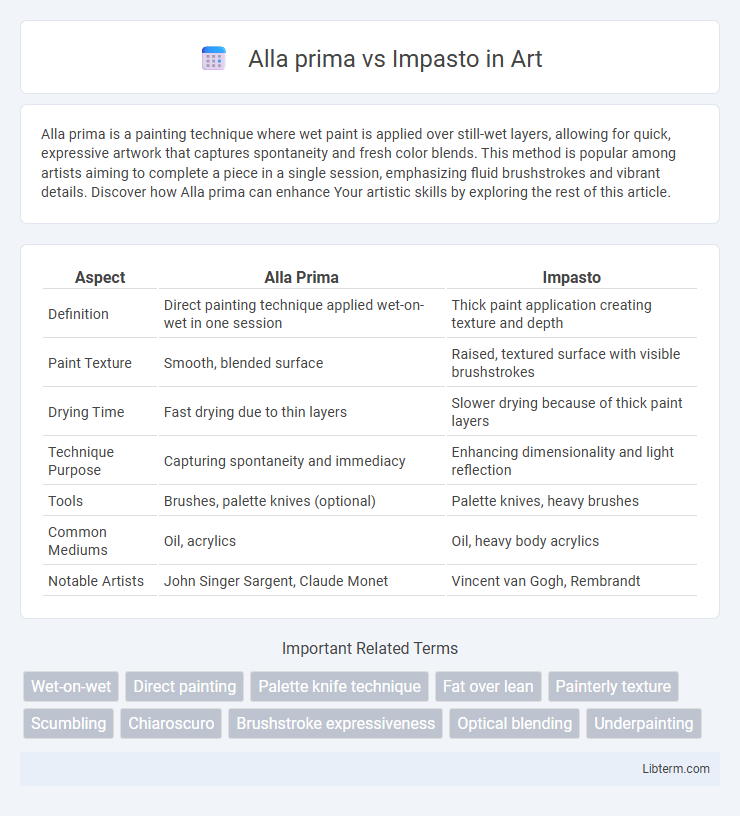Alla prima is a painting technique where wet paint is applied over still-wet layers, allowing for quick, expressive artwork that captures spontaneity and fresh color blends. This method is popular among artists aiming to complete a piece in a single session, emphasizing fluid brushstrokes and vibrant details. Discover how Alla prima can enhance Your artistic skills by exploring the rest of this article.
Table of Comparison
| Aspect | Alla Prima | Impasto |
|---|---|---|
| Definition | Direct painting technique applied wet-on-wet in one session | Thick paint application creating texture and depth |
| Paint Texture | Smooth, blended surface | Raised, textured surface with visible brushstrokes |
| Drying Time | Fast drying due to thin layers | Slower drying because of thick paint layers |
| Technique Purpose | Capturing spontaneity and immediacy | Enhancing dimensionality and light reflection |
| Tools | Brushes, palette knives (optional) | Palette knives, heavy brushes |
| Common Mediums | Oil, acrylics | Oil, heavy body acrylics |
| Notable Artists | John Singer Sargent, Claude Monet | Vincent van Gogh, Rembrandt |
Understanding Alla Prima Painting Technique
The Alla Prima painting technique, also known as "wet-on-wet," involves applying fresh layers of wet paint directly onto previous layers without allowing them to dry, enabling artists to complete a work in a single session. This approach contrasts with Impasto, where thick layers of paint create textured, three-dimensional surfaces, often built up over multiple sessions. Understanding Alla Prima requires mastering fluid brushwork and color blending on the canvas, emphasizing spontaneity and immediacy in capturing the subject.
What is Impasto in Art?
Impasto in art refers to a technique where paint is applied thickly onto the canvas, creating texture and depth that stands out from the surface. This method emphasizes brush or palette knife strokes, allowing light to interact with the raised areas and enhancing the three-dimensional effect. Unlike alla prima, which focuses on wet-on-wet direct painting, impasto highlights the tactile quality of paint, often adding expressive intensity to the artwork.
Key Differences Between Alla Prima and Impasto
Alla prima is a direct painting technique where wet paint is applied over wet layers, enabling rapid completion and smooth blending of colors in one session. Impasto involves thickly layering paint to create textured, three-dimensional effects that emphasize brushstrokes and surface details. Key differences include drying time, texture, and method: alla prima favors fluid, immediate work with a flat finish, while impasto emphasizes volume and tactile depth through heavy paint application.
Historical Origins of Alla Prima and Impasto
Alla prima painting originated during the Renaissance period, popularized by artists such as Titian and later elevated by Impressionists like Claude Monet who embraced wet-on-wet techniques for immediacy and spontaneity. Impasto, characterized by thick, textured paint application, dates back to the Baroque era with masters like Rembrandt who used it to create depth and dramatic light effects. Both techniques have historical roots that shaped their distinctive aesthetics and continue to influence contemporary painting styles.
Materials and Tools for Each Technique
Alla prima painting requires smooth, wet-on-wet brushes such as sable or synthetic filberts and uses oil or acrylic paints thinned with mediums like linseed oil or acrylic retarders for blending. Impasto technique relies on stiff bristle brushes, palette knives, and heavy-bodied paints enriched with impasto mediums, modeling paste, or gels to build textured, three-dimensional layers on canvas. Proper canvas priming and a sturdy support are essential in impasto to hold the thick paint structure, while alla prima uses flexible supports suitable for faster drying and blending.
Popular Artists Who Used Alla Prima vs Impasto
Alla prima painting, characterized by wet-on-wet technique, was famously employed by artists like John Singer Sargent and Claude Monet, who prized spontaneity and fluid brushwork to capture fleeting light and movement. In contrast, impasto technique, known for its thick, textured layers of paint, was popularized by Vincent van Gogh and Rembrandt, whose vigorous strokes created expressive surfaces and dramatic depth. Both techniques highlight different artistic intentions, with alla prima emphasizing immediacy and impasto focusing on tactile richness.
Texture and Finish: Alla Prima vs Impasto
Alla prima painting delivers a smooth, wet-on-wet texture that results in a fresh, cohesive finish with visible brushstrokes blending seamlessly. Impasto technique creates a thick, raised texture by applying heavy layers of paint, giving a three-dimensional, tactile surface and pronounced highlights. The choice between Alla prima and Impasto significantly influences the artwork's texture, depth, and overall visual impact.
Step-by-Step Approaches: Alla Prima vs Impasto
Alla prima painting involves applying wet paint directly onto wet layers without waiting for drying, emphasizing swift, fluid brushstrokes to capture spontaneity. Impasto technique builds textured, thick layers of paint, allowing for visible brush marks and depth, often applied in multiple stages to achieve dimension. Artists choose alla prima for immediacy and fresh blends, while impasto requires patient layering to enhance tactile surface effects.
Advantages and Challenges of Each Technique
Alla prima painting offers the advantage of immediacy, allowing artists to complete artworks in a single session with fresh, vibrant color blending, which enhances spontaneity and expression. Challenges include the need for skillful timing and swift decision-making to manage wet paint layers before drying, limiting opportunities for correction. Impasto technique provides rich texture and depth by applying thick layers of paint, creating a dynamic, tactile surface that captures light and adds emotional intensity, but it requires longer drying times and careful handling to avoid cracking and pigment instability.
Choosing the Right Technique for Your Art Style
Alla prima painting involves applying wet paint layers directly onto each other without waiting for drying, ideal for artists who prefer spontaneity and bold brushstrokes. Impasto, characterized by thick, textured paint application, suits artists aiming to add depth and expressive dimension to their work. Selecting between Alla prima and Impasto depends on your desired texture, drying time, and the emotional impact you want to convey in your art.
Alla prima Infographic

 libterm.com
libterm.com